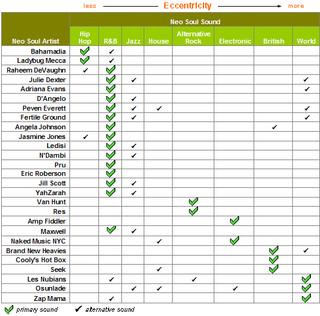Neo Soul Lexicon: Sound
By Sean
Editor-in-Chief, Neo Soul Today
This third installment of the Neo Soul Lexicon Series is devoted to categorizing the different sounds of neo soul.
Vocabulary Prerequisites
Before delving into sound, to prevent any confusion or misinterpretation, it is worthwhile for you to know what we mean by the following terms: neo soul, neo soul artist, and contributing artist. When using the term “artist” in this installment, we are referring to neo soul artists as opposed to contributing artists.
Sound
Sound is the essential attribute that describes the auditory characteristics of neo soul songs, artists, and the artform itself. Although, each artist realistically has her own unique sound, it generally falls into one of 8 well-defined sound categories. These 8 sound categories are collectively called the sound range of the neo soul artform. The neo soul sound range is a continuum of the different sounds of neo soul ranging from the least eccentric to the most eccentric. In order to easily classify neo soul sounds for the purposes of more effectively purchasing, marketing, writing, producing, remixing, and matching of tastes, we have isolated 8 discrete categories along the sound range. While these sounds can be categorized any number of different ways, we thought it important to strike a balance between isolating sound categories that are most identifiable to people, not missing key ones, and keeping them down to a number that is easy enough to remember. We believe confusion will set in if the number of neo soul sound categories exceeds 8.
One or more neo soul sound categories can be used to characterize individual songs, artists, or the artform itself. When characterizing artists, obviously for many, each of their songs has its own sound. Many neo soul artists are enormously talented and have songs with vastly differing sounds. Nevertheless, each artist has what we call their primary sound. An artist’s primary sound is that which applies to the majority of all of the work she has ever done.
The 8 sound categories of neo soul, listed in order of increasing eccentricity, are:
Hip Hop: Neo soul infused with elements of the hip hop genre such as rap and beats. Artists include, but are not limited to, Bahamadia and Ladybug Mecca.
R&B: Neo soul infused with elements of the rhythm and blues genre. R&B has the most overlap with neo soul since classic soul and R&B have the same roots. A majority of neo soul artists have R&B as their primary sound. Artists include, but are not limited to, Jill Scott and Eric Roberson.
Jazz: Neo soul infused with elements of jazz. Ledisi’s album “Feeling Orange But Sometimes Blue” (2002) is entirely devoted to this sound.
House: Neo soul infused with elements of deep house. Ever After from Seek’s “Venus and Mars” album (1999) falls into this sound category.
Alternative Rock: Neo soul infused with elements of alternative rock such as acoustic and electronic guitar and more treble than bass. Artists include, but are not limited to, Res and Van Hunt.
Electronic: Neo soul infused with elements of electronic and computerized instruments. Artists include, but are not limited to, Naked Music NYC and Amp Fiddler.
British: Neo soul infused with elements of the acid sounds from London such as acid jazz and drum and bass. Artists include, but are not limited to, Cooly’s Hot Box and The Brand New Heavies.
World: Neo soul infused with elements of sound characteristic from places around the world outside of the U.S. and England including Paris, Africa, Latin America, and the Caribbean. Artists include, but are not limited to, Les Nubians, Osunlade, and Zap Mama.
The figure below provides examples of 27 neo soul artists and what we believe their primary sound is along with any of their alternative sounds, if applicable.
 We welcome your comments.
We welcome your comments.



2 Comments:
I like the way you break it all down I learn something new every time I read your Blog.
wisdom, thanks for your commentary!!
Yes, indeed, you are right that soul is the sole foundation of neo soul. This is why we love it! QUESTION: Given this, would you say that it is different enough from that classic, back-in-the-day, backyard barbeque soul music such that it should not be simply "lumped in" with soul?
Also, just to be thorough, this installment simply focuses on the different ranges of sound (rooted in soul) that characterize neo soul. R&B is only one sound category along the continuum of sounds that make up neo soul and only two artists were given as examples: Jill Scott and Eric Roberson.
I am also in agreement that much of Vinx's and Fela Kuti's work is rooted in soul. However, they are not neo soul artists. It's hard to categorize Vinx. However, in the context of neo soul, he is a contributing artist. Feli Kuti mainly plays in the world space and it is questionable whether he has contributed any work to modern-day neo soul.
--Sean
Editor-in-Chief, Neo Soul Today
Post a Comment
<< Home